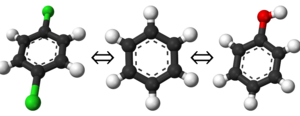Free Energy Fundamentals
| Free Energy Fundamentals |
|---|
 |
|
Methods of Free Energy Simulations
|
| Free Energy How-to's |
|---|
 |
Before one can carry out free energy calculations, one must first understand the underlying principals behind them. This page is dedicated to the most fundamental concepts of free energy calculations and should be an excellent place to start for those wanting to start doing their own calculations. This page also contains some of the common nomenclature and symbols that are seen throughout the rest of the free energy fundamentals pages.
This page is not meant to be an end-all repository of the background mathematics and principals required for free energy calculations, but it will serve as a good start point and hopefully a quick reference.
Assumptions for the Fundamentals
The assumptions listed here are carried out through the rest of the fundamentals sections. It should be noted that free energy calculations do not need these assumptions to be carried out, but to establish a baseline set of simulation conditions and to make conveying the fundamentals easier, they are made. It is encouraged for researchers to explore the literature and develop methods to overcome these assumptions as doing so will advance the field even further.
- A Classic molecular mechanics model will be assumed; this includes:
- Harmonic bond angle terms
- Periodic dihedral terms
- Non-bonded terms made up of point charges and Lennard-Jones repulsion/dispersion terms
- Temperature will be held constant
- QM/MM will not be considered for fundamentals because of the field has yet to be sufficiently developed.[1]
Core Free Energy Equation
Facts from the Core Equation
Nomenclature and Variables
In an effort to keep things uniform, this section contains all the common constants and variables that are seen throughout the fundamentals sections. Although the Table itself is not in any particular order, the sorting buttons should help you find what you are looking for. The alternate listings of some variables are things one may encounter in literature, although this site will strive to be uniform in its naming process.
| Variable, Acronym, Term | Definition | Notes |
|---|---|---|
| [math]\displaystyle{ U }[/math] | Potential Energy | This is a general potential energy and can be for either canonical ensemble where it is just the natural potential energy, or for grand canonical ensemble where [math]\displaystyle{ U=U_i + PV_i }[/math]. In ether case, the equations work out the same |
| [math]\displaystyle{ k_B }[/math] | Boltzmann's Constant | |
| [math]\displaystyle{ T }[/math] | Temperature | In whichever units you like. Note: This is often shown with [math]\displaystyle{ k_B }[/math] as well, and so common in fact that there is a common variable affiliated with it: [math]\displaystyle{ \beta }[/math]. |
| [math]\displaystyle{ \beta }[/math] | Inverse Boltzmann Temperature [math]\displaystyle{ \beta=(k_BT)^{-1} }[/math] | Because it is so common in most the equations, one will see [math]\displaystyle{ \beta^{-1} }[/math] more often than [math]\displaystyle{ k_BT }[/math] |
| [math]\displaystyle{ P }[/math] | Pressure | |
| [math]\displaystyle{ V }[/math] | Volume (traditional) | NOTE: Volume in this sense is the kind you think of with box size. Not to be confused with the Phase Space Volume. This particular volume is not often considered by itself and should only show up on this site within [math]\displaystyle{ PV }[/math] terms, or NVT. |
| [math]\displaystyle{ V_i }[/math] | Phase Space Volume: Total set of coordinates and momenta where the system has a nonzero probability of being found | NOTE: This is not volume in the traditional sense. It occasionally is seen as the variable [math]\displaystyle{ \Gamma }[/math]. |
| [math]\displaystyle{ q }[/math] or [math]\displaystyle{ \vec{q} }[/math] | Collective variable for coordinates and momentum. | Can also be seen as [math]\displaystyle{ \mathbf{x} }[/math], [math]\displaystyle{ \mathbf{\vec{x}} }[/math], and a number of other terms in literature. |
| [math]\displaystyle{ \epsilon }[/math] and [math]\displaystyle{ \sigma }[/math] | Standard Lennard-Jones parameters | |
| [math]\displaystyle{ Q }[/math] | Partition Function: |
References
- ↑ Woods, C. J., Manby, F. R., and Mulholland, A. J. (2008) An efficient method for the calculation of quantum mechanics/molecular mechanics free energies. J. Chem. Phys. 128, 014109.